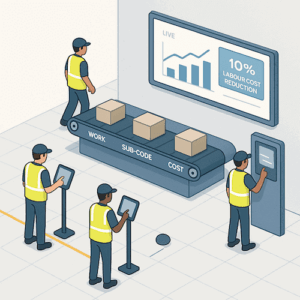Maximise Manufacturing Output and Cut Costs with Smarter Job Tracking

The Challenge of Tracking Labour Across Multiple Jobs in Manufacturing
Manufacturing operations are often a juggling act. Between multiple production lines, custom jobs, and varied client demands, tracking labour hours accurately is difficult. Without the right tools, many businesses rely on manual spreadsheets or disjointed timekeeping systems. These methods are prone to error, offer no real-time visibility, and leave operations managers flying blind when it comes to cost control. Labour is one of your highest variable costs. If you’re not accurately tracking where those hours are going, you’re likely bleeding margin on unprofitable jobs and overstaffed shifts.
How Digital Job Tracking Works
Timecloud’s Job Tracking feature gives manufacturers in Australia and New Zealand a digital system to assign, switch, and monitor labour hours with precision. Using the Timecloud time clock or mobile app, employees can clock into specific job codes, work centres, or cost centres. With support for multiple layers, sub-codes, and job linking, staff can easily switch tasks without skipping a beat. Each clock-in is timestamped, geotagged (if required), and instantly visible on admin dashboards.
Timecloud offers real-time tracking across:
- Mobile app (with PIN login)
- Kiosk mode
- Biometric time clocks
Admin users gain access to live dashboards and reporting tools that show who is working on what, when, and for how long.
Learn more: Job Tracking Overview
Benefits of Job Costing for Decision-Makers
How Modern Manufacturing Businesses Can Save 10% on Labour Costs with Job Tracking in 2025
Most mid-sized manufacturers are struggling with labour blowouts on custom production runs. Staff are clocking in and out of shifts, but there is no visibility into which jobs are taking the most time.
After implementing a solution like Timecloud, producers can configure job layers based on production stage, client project, and machine use. Employees can use a time clock to switch tasks throughout the day.
Within weeks, savvy business owners can identify the specific job types that consistently run 20% or more over budgeted labour hours. Management can reassign labour, rebuild workflows and reduce unnecessary downtime.
The result? A minimum 10% reduction in labour costs over within the first quarter after implementation.
Conclusion
If you’re still trying to track job-level labour hours with paper, spreadsheets or legacy systems, you’re holding your factory back. Timecloud provides modern manufacturing job tracking software that helps you track labour costs, improve productivity, and make informed decisions.
Learn more about setting up job tracking:
Real-Time Accurate Job Tracking

